ANOTOLIKA [The Beach House]
9 nights of our Summer Holiday in August 2010
We drove a short distance along the South Coast of Crete from Chora Sfakion to Plakias, in our hire car; a VW Polo which we nicknamed "the Hot Box", on account of the air conditioning system being wholly inadequate to cope with temperatures hitting 40°C. A further few km on, around a hilly area, and we thought we were nearly there....think again! We hit one of those dreadful tracks which used to pass for a road, now considered so rough that the road signs have all been blanked out. Unfortunately, we had no choice but to take it anyway. Nearly an hour later, having travelled all of 6km, we had finished bouncing along the dusty road, avoiding potholes and rocks; we found our little idyll, and home for the next 9 nights.
The garden was shaded with palm, fig and orange trees. There was a pergola in the middle of the garden with table and chairs, and a hammock beneath. 4 sun beds were laid out for us to manoeuvre around to maximum effect. On the side of the house was a "cooking station", consisting of charcoal barbeque, and...wood-fired oven! On the front of the house was a sheltered terrace with space to enjoy an evening meal, and a couple of laid-back ginger tabby cats, happy to sleep throughout the day, sandwiched around the 2 meals we were able to offer, as the owner had left goodly cat food supplies!
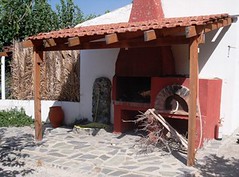
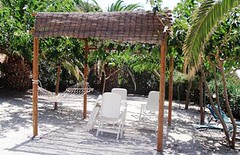



Inside the house was fine, although the mattress on the bed was rock solid compared to the usual comfort we enjoy. We had temporary supplies to keep us in food for a couple of days, including a bag of flour, and a levain in need of a feeding frenzy. It was Sunday afternoon, and I planned to bake Monday late morning. We had a brief evening stroll to get our bearings, and gathered a load of wood ready to fire the oven.
I awoke early, so got up and made dough using the leaven I had brought with me from the UK, and fed 3 times the day before. Kicking, but cool from a few hours in a lovely cold refrigerator! What to make??
Well, the flour was carefully chosen, as Alison can read Greek ok. The text on the bag revealed the flour to be of Cretan origin, although I figured it was a mainstream flour, rather than specialist. A protein content of 11.2% [see label], made me confident I could make reasonably good bread with it, although the example recipe given on the bag suggested water should be added at 57%, which I thought was a trifle low for what I wanted to make. But, I had no scale! Given the detailed formula I usually prepare for baking, the guesswork I was about to indulge in seemed a little daunting. My estimate for total hydration used in the formula would be just over 70% [total guess].

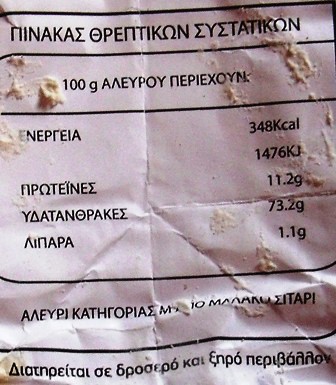


The dough was pretty wet, but I knew it would work up well. Sure enough, after 15 minutes "air-kneading" [© Andrew Whitley], the dough was soft, but silky and wonderfully extensible. I placed it on a kitchen surface brushed with olive oil, and covered it over. So, better get that oven fired whilst giving the dough a sequence of "stretch and fold", and preparing garlic for a Roasted Garlic Foccacia.
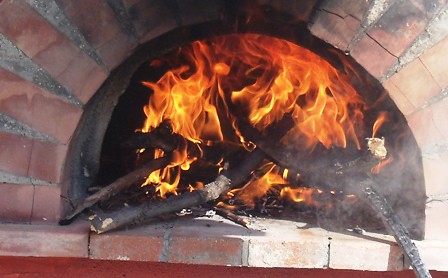
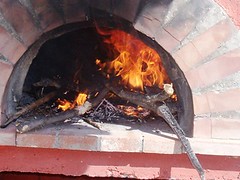
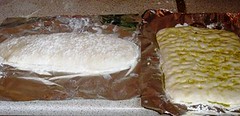

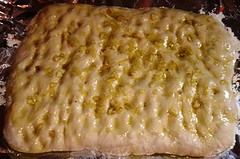
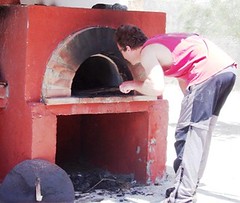
I also decided to make a Ciabatta loaf, and a loaf with a swirl of Black Olive Paste through the middle. The dough proved relatively rapidly compared to what I am used to in the UK. Still, the wood I had gathered was tinder dry, so burnt straightaway...and HOT! The main problem proved to be getting the oven to drop and settle ready to bake on. The "Olive Swirl" bread was now in need of baking. A quick scuffle of the oven, and I set the loaf in the oven, resting on the aluminium foil strip used for proving. I covered the loaf with a large roasting pan lid, put the door in place on the oven, and left for 10 minutes to prepare to bake the other 2 loaves. I then finished the first loaf without the lid, and it took colour beautifully. Baking the other 2 loaves was very simple, and testament to good dough quality, guaranteed through careful product choice to match up to assumed flour characteristics. This worked well, and we had a few days' supply of lovely breads for our lunches under the pergola.
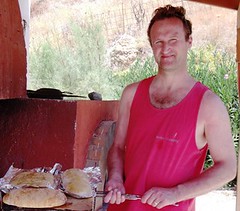
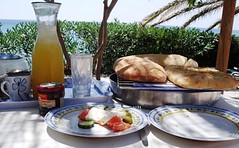

On Tuesday we went off in the "Hot Box" to the nearest town, Spilli, some 25km over the mountains. We came back with lovely fresh fruit and vegetables and other supplies, including Ouzo, and another bag of the very same flour! Over the entire time we spent at Anotlika, we didn't eat out once. Yet we really did feast on fine food...which I cooked without wasting anything. We lived quite simply, in many ways, and yet it seemed to cost so much money. The £ to € conversion seemed always to work against us, and clearly the struggling Greek economy has hit food prices badly. Still, we were on holiday, and loving every minute of it.


Back at the Beach House, we went swimming in a sea which became increasingly rough. The weather stayed very hot throughout, so an afternoon swim became an essential feature of my day. The beach was literally the other side of the road running past our house, so the trip into the sea was all of 25 metres.


The next bake was scheduled for Thursday 5th August. I made a large boule, and also made a sweet dough which I flavoured with honey and cinnamon, and used both egg and olive oil to improve and condition the dough. Last year during our stay at Finnix, we had been given bread at the local hotels and restaurants, which had been made to celebrate the Orthodox Festival "Metamorphosis". The bread was made in the style of large boules, but it was sweet. This year, the Priests had been much in evidence at the Old Phoenix Hotel where we stayed, but the actual festival fell on the 5th August. So, my take on this bread did coincide with the festival itself; just for fun, neither of us have connections to the Orthodox religion.
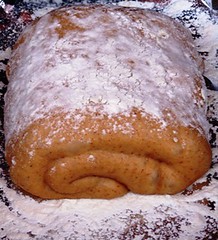
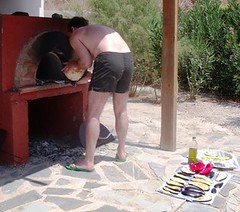
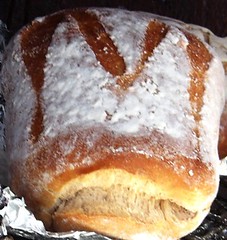
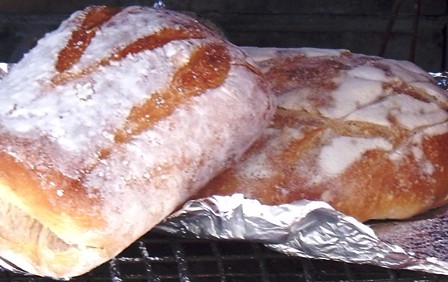
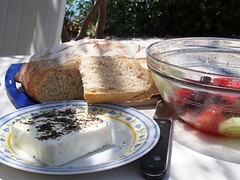
Alison pronounced the breads to be as good as any of my breads she had eaten. Of course, the context is of great importance too; being able to eat fresh bread just cooled, but straight from a wood-fired oven. The cracks in the crust of the boule betray exactly how lovely the crust was on this bread. Alison usually enjoys the heavy crumb texture of high rye doughs; feasting on this type of crusty bread at its peak was a novel experience, and she fully appreciated how special it was too!
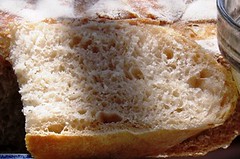
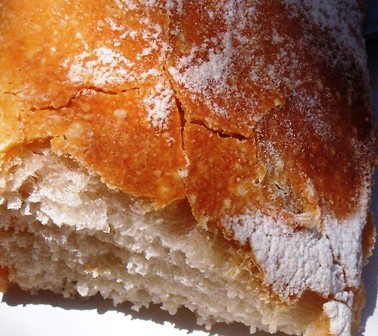
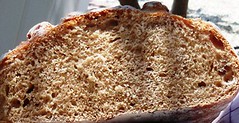
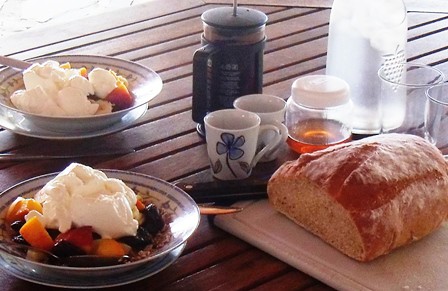
After that I set 2 pans of vegetables to roast. The pictures say it all. I sun dried aubergines, peppers and courgettes before roasting them slowly in the falling oven for 3 hours. Wow, these vegetables sustained several meals during the rest of the holiday!
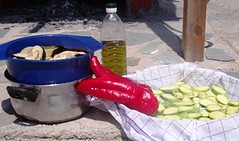
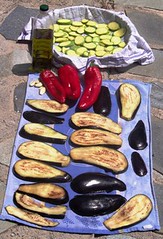
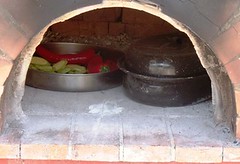
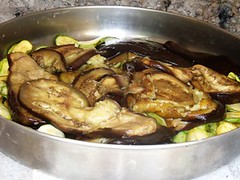

We were shaken awake early on Sunday morning [8th August], by an earthquake out to sea, but very nearby at Gavdos. The tremor was way below sea level but measuring 4.8, so we felt an obvious tremor beneath the house, which led to us rising from our bed somewhat earlier than originally planned. See: http://greece.greekreporter.com/2010/08/09/crete-and-rhodes-islands-shaken-by-earthquakes/
The holiday passed as we wanted it to. Nothing had been planned in a way which interrupted our simple daily routines. That had been the original purpose for going to this place. Both of us had worked ourselves close to the limit by late July, and a break of this sort was essential for us to effect battery re-charge.
I did set about reading Stephen Kaplan's book on the renaissance of good bread in France. It's a weighty tome, and I found I needed to take down a lot of notes as I read. However, it's enjoyable to read, and the man's clearly passionate in a way I feel echoes my own approach to teaching. There are some great references in the book too; I wish my French was better than it is!
Well, we really did not want to come home...of course. The reality check kicked in on the last day, when we had to drive back to Heraklion and submit to the horrors of passing through a wholly inadequate airport as a holidaymaker amongst many, many others. Three flights back to the UK, all within half an hour of each other, all checking in the same desk....hell on earth. The flight arrived back in Newcastle at 10pm, and less than 12 hours later, I was back at work, excitedly putting in place the fabric which will become a Level 3 ["A" Level equivalent] Bakery course to sit alongside the other programmes I already run. Quite a coup, but I'd have liked a longer holiday, of course!
With regard to Greek bread, I had only limited opportunity to explore the local offerings. We stayed in a lovely boutique hotel in Heraklion on the first night. The breakfast offer the next morning seemed outrageously extravagant to Alison and me! We enjoyed muesli and lovely stewed prunes with yoghurt and honey, then had scrambled eggs with some rye bread we could slice off. Everybody else seemed to be tucking into the fluffy white enriched breads and rolls to support vast amounts of bacon and sausage. This frequently ran to seconds, before a final return to gather up indulgent Greek pastries. The rye breads were ok, but I'm sure they were made from a "pre-mix", straight out of a bag with a Bakels, or IREKS name attached; just add water and yeast. The bread at the Old Phoenix Hotel is always good; it comes from nearby Chora Sfakion, and is made as large white boules of clearly beautifully fermented bread. We had a visit to Rethimnon on the way back but had no time to investigate the one bakery recommended in the Rough Guides for its rye breads. The restaurant where we enjoyed a gorgeous lunch did put out very simple, but tasty homemade white and wholemeal slices of bread with a tapenade, and a beetroot and yoghurt dip...everything clearly homemade: yummy!
Best wishes to all
Andy